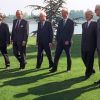A process without historical precedent
Germany has been reunited since October 3, 1990. The peaceful revolution of the people in the GDR had brought down the Wall that had divided Germany into east and west.

November 9, 1989, the day on which the Berlin Wall fell, marked the climax of a trend that was similar to a revolution and in which the citizens of the GDR played the main role. Some, because they did everything in their power to leave a state that refused to grant them the freedom to travel and who by occupying embassies abroad forced the authorities into allowing them to leave, and others because they proclaimed in no uncertain terms that they wished to stay in the GDR. However, they also demanded fundamental reforms, which the regime could not agree to without setting its downfall in motion. Given this assault on two fronts, despite massive security measures the GDR collapsed like a house of cards in the space of just a few months. This paved the way for the division of Germany to be overcome and for the country to be reunited on October 3, 1990.
Dieses YouTube-Video kann in einem neuen Tab abgespielt werden
YouTube öffnenThird party content
We use YouTube to embed content that may collect data about your activity. Please review the details and accept the service to see this content.
Open consent formAt the beginning of 1989 hardly anybody in Germany, either in the west or east, had anticipated that the 40th anniversary of the GDR in the fall would also be its last, that the Berlin Wall would soon disappear, and that Germany, which was divided into two states, would be (re-) united. No one had suspected that as a result the political constellations that had dominated post-War European politics for more than forty years would dissolve. But then everything changed. All at once history, which for decades had been evolving at a snail’s pace in Europe, began trotting, before finally breaking into a wild gallop. The speed of the changes even took the breath away from those observers who were mere onlookers and not themselves directly involved in the course of events. A mere ten months after the fall of the Wall the Two Plus Four Agreement signed on September 12, 1990 paved the way for the reunification of Germany.
For a short time, German Unity, which in constitutional terms was completed on October 3, 1990 with the accession of the five new federal states “to the area of validity of the Basic Law of the Federal Republic of Germany”, triggered exuberant collective joy, borne by the certainty of being able to shoulder the challenges of the unification process. What followed, however was what Bertolt Brecht once called “the trudge across the flatlands”. The difficulties many Germans had with their newly found freedom were also a consequence of the fact that it came when hardly anybody had been expecting it and at a speed no one was used to.
Dieses YouTube-Video kann in einem neuen Tab abgespielt werden
YouTube öffnenThird party content
We use YouTube to embed content that may collect data about your activity. Please review the details and accept the service to see this content.
Open consent formYou would like to receive regular information about Germany? Subscribe here:




